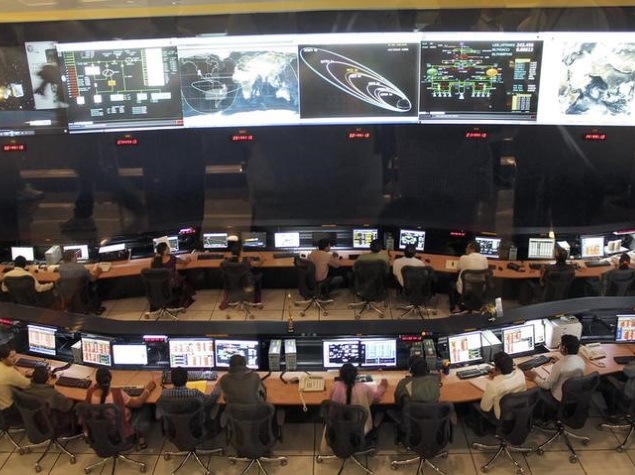- Home
- Science
- Science News
- India Prepares to Launch Third IRNSS Navigation Satellite Early Thursday
India Prepares to Launch Third IRNSS Navigation Satellite Early Thursday

"Today (Wednesday) morning we moved the mobile service tower (MST) backwards. The operation was delayed by around two hours owing to thunderstorm in the morning. There is sufficient time cushion built in for such unforeseen delays in the countdown period," M.Y.S. Prasad, director, Satish Dhawan Space Centre at Sriharikota, told IANS.
"At 10pm IST, based on the climatic conditions like thunderstorm, we will decide on the launch. Currently everything is normal," he added.
Prasad said the filling of propellants in the second stage/engine would be completed by 2pm IST.
Following that the gases in the various stages would be pressurised.
At 1.32am IST Thursday, the Indian rocket Polar Satellite Launch Vehicle (PSLV-C26) carrying the 1,425-kg navigational satellite badged as Indian Regional Navigation Satellite System-1C (IRNSS-1C) will launch. The 44.4 metres tall rocket, weighing around 320 tonnes, is expected to spit out the satellite into the space around 20 minutes after the blast-off.
Once the satellite is successfully placed in its orbit, India will be just one more satellite away from having its own satellite-based navigation system.
Indian Space Research Organisation (Isro) chairman K. Radhakrishnan had earlier said, though IRNSS is a seven-satellite system, it could be made operational with four satellites.
On October 12, Isro's Launch Authorisation Board (LAB) gave its nod for the launch. The countdown began Monday morning.
Originally the satellite was scheduled to launch October 10, but was put off by a week due to a glitch in the telemetry system.
During the countdown, propellant filling activities would be carried out along with checking of the various systems.
The satellite is part of the Indian Regional Navigation Satellite System (IRNSS) that will have a constellation of seven satellites to provide accurate positioning service for terrestrial, aerial and maritime navigation in 1,500km-area in the Indian peninsula.
The second navigation satellite (IRNSS-1B) was launched April 4 this year from the spaceport. The first one - IRNSS-1A - was launched July 2013.
The Indian system will be similar to the US Global Positioning System (GPS), Russia's Glonass and Europe's Galileo constellation of navigation satellites.
India began its space journey in 1975 with the launch of "Aryabhatta" using a Russian rocket and till date, it has completed over 100 space missions including missions to the Moon and Mars.
Catch the latest from the Consumer Electronics Show on Gadgets 360, at our CES 2026 hub.
- Samsung Galaxy Unpacked 2025
- ChatGPT
- Redmi Note 14 Pro+
- iPhone 16
- Apple Vision Pro
- Oneplus 12
- OnePlus Nord CE 3 Lite 5G
- iPhone 13
- Xiaomi 14 Pro
- Oppo Find N3
- Tecno Spark Go (2023)
- Realme V30
- Best Phones Under 25000
- Samsung Galaxy S24 Series
- Cryptocurrency
- iQoo 12
- Samsung Galaxy S24 Ultra
- Giottus
- Samsung Galaxy Z Flip 5
- Apple 'Scary Fast'
- Housefull 5
- GoPro Hero 12 Black Review
- Invincible Season 2
- JioGlass
- HD Ready TV
- Laptop Under 50000
- Smartwatch Under 10000
- Latest Mobile Phones
- Compare Phones
- OPPO Reno 15 Pro Max
- Honor Win RT
- Honor Win
- Xiaomi 17 Ultra Leica Edition
- Xiaomi 17 Ultra
- Huawei Nova 15
- Huawei Nova 15 Pro
- Huawei Nova 15 Ultra
- Asus ProArt P16
- MacBook Pro 14-inch (M5, 2025)
- OPPO Pad Air 5
- Huawei MatePad 11.5 (2026)
- Xiaomi Watch 5
- Huawei Watch 10th Anniversary Edition
- Acerpure Nitro Z Series 100-inch QLED TV
- Samsung 43 Inch LED Ultra HD (4K) Smart TV (UA43UE81AFULXL)
- Asus ROG Ally
- Nintendo Switch Lite
- Haier 1.6 Ton 5 Star Inverter Split AC (HSU19G-MZAID5BN-INV)
- Haier 1.6 Ton 5 Star Inverter Split AC (HSU19G-MZAIM5BN-INV)












